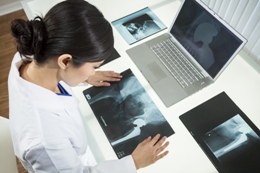20 February 2015
 University of South Australia researchers are developing new technology to reduce the risk of post-operative infection in biomedical implants such as hip and knee replacements.
University of South Australia researchers are developing new technology to reduce the risk of post-operative infection in biomedical implants such as hip and knee replacements.
With more than 90,000 hip and knee replacements performed in Australia in 2014, and the country’s population continuing to age at a rapid rate, the technology has the potential to bring significant benefit to both patients and the biomedical industry.
CEO of UniSA’s commercialisation arm ITEK Ventures, Dr Stephen Rodda, says the technology developed out of UniSA’s Mawson Institute is primed for commercial development.
“This medical implant coating is another outstanding piece of technology to arise out of UniSA research and will make an excellent investment for anyone interested in future industries in South Australia,” Dr Rodda says.
Mawson Institute Director Professor Hans Griesser says the coating for medical implants combats infection by ‘stunning’ bacteria and discouraging them from forming infectious biofilms around the device.
“This cost-effective surface coating technology has the potential to transform biomedical devices and implants such as external fixation pins, hip and knee replacements, stents and catheters, which remain vulnerable to infection during postoperative recovery,” Prof Griesser says.
The novel coating releases nitric oxide, a biological signalling molecule. Nitric oxide is involved in signalling processes across a wide range of bacteria that can cause infection, making the coating suitable in the fight against a wide variety of implant and device infections.
Prof Griesser says not many people realise that bacteria communicate with each other and act cooperatively. Interfering with this communication reduces their ability to form a biofilm colony.
“Bacteria are social organisms that ‘talk’ to each other about whether a location is suitable for feeding and growth – and thus cause infection,” Prof Griesser says.
“We’ve designed a material that releases this molecule at a suitable concentration, which sends the message that it’s not worth staying around."
The biological consequences of nitric oxide depend on the dose, but generally these chemical messengers released from the coating interfere with the cell-to-cell communication between bacteria called quorum sensing, and also can induce bacteria to break up an infectious biofilm, making the bacteria more susceptible to conventional antibiotics.
 “One or two bacteria are not a problem, but once they settle and multiply they become a problem," Prof Griesser says.
“One or two bacteria are not a problem, but once they settle and multiply they become a problem," Prof Griesser says.
"After multiplying they form a protective biofilm which is harder to combat. It’s better to tackle bacterial infections before they have proceeded to the biofilm stage.
“Outside a biofilm, when they disperse, and are floating around in the blood stream, they are much more susceptible to the body’s natural immune defences and antibiotics.”
According to Prof Griesser, the same signalling molecule is also involved in human wound healing processes, so delivering it directly from devices and implants also promotes better wound healing.
While wound healing data are not yet available, he expects a dual benefit in that these released molecules should accelerate wound healing and at the same time stop bacteria from causing wound infections, which delay or even prevent healing.
Prof Griesser and his team are now looking further afield for medical applications for the technology.
“We’re looking at new applications where we don’t want to kill the bacteria – which releases toxins – but we want to stop them multiplying around the biomedical devices and forming biofilms.
“Importantly, the coating can be fine-tuned to different implants and devices, to address specific infection-risk circumstances.
“Our invention is based on an environmentally friendly process called plasma polymerisation, which is already used on a large scale by biomedical companies, such as for coating contact lenses and sutures, to deposit thin coatings effectively and with exquisite control of the properties of the coatings.
“In future our coatings might equip a wide range of devices and implants with the ability to release nitric oxide locally, where it is needed, to protect against infections at devices and implants.”
Dr Rodda says ITEK is looking for a commercial partner to take the technology to trials, with the goal of developing a commercial product in the next five years. Contact ITEK commercial manager Peter Harriss on 8302 5180.
Media contact: Peter Krieg office 8302 0965 email Peter.Krieg@unisa.edu.au
or Kelly Stone office 8302 0963 mobile 0417 861 832 email Kelly.stone@unisa.edu.au




